I first tried Across Toss (last week) with a group of 6th & 7th graders. I wanted to weave in the idea of making agreements (i.e., norming, Full Value Contracting), understanding agreements, keeping agreements and sharing voice or 'speaking up' as I framed it. (There can also be some work on how we manage and treat mistakes within the group - this was a secondary focus for me.)
In this What? & Why? format, I'll break the activity down step-by-step. (There are more What? & Why? activity breakdowns at this blog site if you are interested in this format. Go to Categories - down the right side of this page - and click on What? & Why? If you want the philosophy behind What? & Why? - spoiler: a training resource - read the intro to Name Card Return: What? & Why?)
Reality Check: In reality, real time, I spent about 15 minutes on this activity (of the 90-minute team building activity portion of the program - three more hours were spent on the high course where 'making agreements' carried over) in order to make the learning points - mainly, making and keeping agreements. It's amazing to me how much (decision-making) goes into facilitating such a short activity.
(This section is about What I did, and will generally do, when leading Across Toss)
1. I have a game spot and two safe tossables for each participant ready to go. (My tossables were stress balls, a squeaky penguin and some inflatable orbs a little bigger than a softball.)
2. I gave everyone a game spot and asked them to circle up - about a one-arm length apart from each other - and then instructed them to stand on their spot.
3. There were eight participants in the group, including me (I played as well). I chose to start with three tossables. I handed out the tossables to three different people.
4. I frontloaded the activity with this information: "This activity is about making agreements with your group members. For example, one will be, who will agree to catch the object you have to toss - if you have an object to toss. Another one I'm going to ask you to make is to agree to speak up if you are unsure of anything during the activity."
5. I interject here: "Throughout our program together, I'm going to be asking you to make other kinds of agreements. We'll have the opportunity to discuss the agreements before you commit to them. And, maybe there will be some agreements you can't make - and that's okay. We will work through this as well."
6. I go on to ask for one agreement now: "So, can you all agree to speak up any time you are unsure about something during the activity? This might be difficult to do, but I'm asking you to try. Can I get a thumbs up if you agree?"
7. I provide the challenge at this point: "Here's how the activity works. As a group, our objective is to catch as many objects as we can - twice in a row. I'll explain this in a moment. We play the game in a series of Rounds. For Round 1 we have three objects to toss - hold up your object if you have one in your hand. Cool, thanks.
Each Round will have at least two toss attempts, maybe more. I, for now, will begin each toss attempt by saying, 1, 2, 3, toss. On the word 'toss' everyone must toss his or her object to someone else in the group - you are not allowed to toss an object to yourself. If all the objects are caught on this first toss, we go for another toss with these three objects. I will say again, 1, 2, 3, toss. All objects must be tossed at the same time - objects can't be tossed to yourself AND you may not toss it back to the person who just tossed it to you. Now, if we catch all the objects this second time, we will add another object to the challenge - this is what I mean by catching the objects in play twice in a row. When we add an object, we move into the next Round.
Again, the challenge is to see how many objects we can catch twice in a row. So, the more Rounds we play, the more objects we catch.
If an object drops to the ground after a toss, we simply try again. We can view a drop as a mistake - will it be okay to make a mistake during the activity? Who's made a mistake before? How do you like to be treated after making a mistake? How do you treat yourself after making a mistake? How do we want to treat ourselves and each other after making a mistake? Again, if a drop happens we get to try again. The bottom line is that we will play each Round until we can catch the object in play twice in a row."
During this first attempt at Across Toss, I did take a little time to 'check in' on the drops. I asked if there if they could tell me why the object dropped and what could be done to prevent this type of drop in the future - again, a quick check.
9. At this point I ask if there are any questions about the challenge or directions.
10. It's time to toss. "Okay, let's give this a try. Everyone with an object, please make an agreement with someone in the group that will try to catch your toss. Then, you all let me know when you are ready for the toss."
11. I confirm, "Is everyone ready? Are you sure? Tossers, who is your agreement with?" I have them each point out who they have an agreement with. "Okay, here we go. 1, 2, 3, toss." At this point, we play this round with me calling the toss, until the group catches the objects twice in a row.
12. When the group is successful, we celebrate with hoots and claps!!
13. Here I ask, "Just to check in, what agreements did you make so far? Were you able to keep your agreements? What happened if an agreement was not kept? Are there any questions or concerns about our agreements so far?
15. After our new agreement I introduce another object. I ask, "Do you all want to add in another object, all the same rules apply, or do you think that three objects is our best effort at this time? What is your truth on this?" From this point we go to the next Round or decide together to stop and move on to another activity. If the group decides to move on to the next activity, we process our Across Toss experience (see below, Step 17) before moving on.
16. Playing the next Rounds: Rounds continue until the group 'agrees' that they have done the best they can, at that particular time, and want to move to another activity. For each Round the rules are the same - when you have an object (or two) to toss, make an agreement with a catcher (or catchers). Then, everyone tosses on the word 'toss.' The group makes tosses until they can catch the objects twice in a row OR they decide, during a Round, they have achieved their best effort.
17. Processing Across Toss: In the end, I focused on one area of understanding, making and keeping agreements. Even though I did bring up some other learning moments - how will we treat each other when a mistake is made and preventing future drops (problem solving), I focused on the one topic for take aways. Here are some of the questions I used (to the best of my recollection):
- What were the agreements we made for this activity?
- How did you, specifically, do keeping your agreements?
- If you couldn't keep an agreement, what happened? Did any feelings show up for you? Which ones and why do you think they showed up?
- What was it like for you to keep an agreement? What feelings showed up for you after keeping an agreement?
- What agreements are you in right now in your life outside this program? Are they easy? Are they difficult? Are they important?
- If we can't keep an agreement, what are some good ways to handle this situation?
- Does anyone have an idea for an agreement we would want to make as a group moving forward today?
(In this section I give you the Why behind what I did for each step.)
1. I like use games spots if I have them - they provide clear information about where to stand when I want to keep this a constant. For Across Toss you don't need game spots.
I chose to use a variety of tossable objects. I like the visual diversity and it provides an opportunity for participants to speak their truth. For example, in this first attempt at Across Toss one of the participants (during Round 4 I think) did ask if someone else would be willing to make an agreement with her tosser because the ball he had was small (stress ball) and hard to catch. To solve this, someone in the group traded objects with the tosser so he could have a larger object - the catcher was then comfortable enough to make an agreement with her tosser. Good Stuff!!
2. The circle with one-arm spacing is good, in my opinion, for tossing-types of activities - players are not tossing over anyone. I decided if they asked to resize the circle I would let them, but if they ask to change the shape of their formation, I would not let them. In my thinking, I took away some problem-solving options (not an objective I was working on at the moment) in order to focus on the topic of making agreements.
3. Handing out three objects at the start, in my mind, saved some time - we could have started with one object, progressing from there. But, I believed the group could handle three at the get-go. To start, I would go up to half the group starting out with an object, so half are catching and half are tossing. However, I wanted to have a couple Rounds of practice, and confidence building, before someone in the group had to both toss and then catch. And, I included myself in the action because this one seemed easy to observe while playing due to the controlled nature of tosses. I felt confident that I could, toss, catch and observe all at the same time if needed.
4. Here I simply told them about what we would be working on during the activity so they could anticipate (a bit), what they would be talking about. This can be considered the, 'WHY they are doing this' part of the introduction. Providing a couple examples then jump-starts the brain towards what to expect. I also knew that this middle school age group would understand what an agreement is so I didn't go into defining an agreement - but, this could be done.
5. This 'interjection' is also another anticipatory set (education theory term). Using Across Toss to introduce agreements would give me some experience to go back to during the program when we made new agreements or were still keeping our initial agreements. For example, I used this during the high course part of the day, "Remember during Across Toss I asked you to make the agreement to speak your truth, even if it would be difficult to do? Well, I'm still asking you to keep this agreement - to speak your truth about the Leap of Faith. What is your truth?" (This participant was feeling pressured by a friend to climb the pole, but I could tell he really didn't want to. So, I asked him for his truth.) He chose not to climb and to be the anchor for the belay team. Again, good stuff!
6. Here I asked them to make their first agreement. I felt it was a reasonable first step - basically asking them to ask questions if they had them. In my experience, this is a pretty easy agreement to make (sure I can ask questions), but it is sometimes difficult to really keep (I'll look stupid to others if I ask this question). This makes for a good processing question - "How many of you had a question or a concern you wanted to voice, but didn't? Why do you think that is?" A good thread to tease out.
7. This step is about flushing out the directions. I chose to start out saying the countdown, 1, 2, 3, toss, so I could model this role. In my plan, I was prepared to pass on this role to someone in the group - giving the group, as a whole, more responsibility. However, it didn't feel right to pass this role on with this group. (By all means, pass this role off if it feels good to do so.)
I didn't (and usually don't) get into to super detail with the rules, I want to get them playing. Playing allows the group the chance to collect some data and then ask better questions.
When talking about drops, I don't spend tons of time here - I don't/didn't make a big deal about it. I did tell my group that, yes, a drop can be seen as a mistake - so how will we treat each other if this happens. Good. Let's move on. Again, my focus for the activity is/was on making agreements. One of the agreements is/was to TRY and catch a toss - so, essentially, catching is/was not required, only a try-to-catch. Now, with that said, could there be some embarrassment around not catching? Yes. But a reminder about making the try is what's important. "Did you try?" Awesome. Then you kept your agreement. Now, we get to TRY again - we get more practice. Isn't this great?!"
9. I believe it's always important to provide the group opportunities to ask questions - and, this was an agreement I asked them to make. My process is this - after asking if anyone has any questions, I look to everyone in the circle, making eye contact with each person for about three seconds. I go around twice (the second time a bit faster). This allows time for everyone to think about a question they have and then formulate how they want to phrase their question. I find this process produces more interaction from the group - they are more willing to share if they have a little time to think and decide.
10. Here I'm asking them to make there first agreement with someone in the group. I don't tell them how to do this - I want them to figure this part out. And, it's not easy for everyone 'ask' something of other people. This is part of the learning. If a solid agreement isn't made, there is confusion and drops. So, I let this play out on its own.
11. Now, before we tossed, I asked everyone to confirm who they made an agreement with. I wanted to hold them accountable for at least Round 1. I did not ask for confirmation in the subsequent Rounds and more drops occurred. And, they did come to realize that without a clear agreement drops were more likely.
Round 1 only needed two tosses - I believe checking in with their agreements helped. We were able to clear up any misunderstandings before tossing. I facilitated the process.
12. We celebrate after the first Round - I celebrated a bit more than they did, they didn't think it was a big deal, yet. And, we did take some time to talk about the importance of celebration and what celebrating can do for motivation. Not a ton of time on this, just planting seeds for later.
14. Before moving into the second Round, I introduced the group to a new process in the challenge. I'm telling them at this time because this is where it's most relevant. I didn't ask them to make this new agreement at the beginning - they didn't need to at the beginning. So, I saved time in the beginning - I didn't overload them with information. Give some in the beginning and add as you go.
At this point they are asked to make another agreement about speaking their truth - even if it's difficult to do. Others might have a different truth. It's about reaching consensus as a group - everyone agreeing to keep going or stop and move on to the next activity.
15. So, when adding one more object to the challenge with each new Round, I asked everyone to speak their truth, whether or not they thought they could be successful - two catches in a row - with another object. Or, were they at their best number of objects.
16. In this first game of Across Toss, the group had no issues with adding another object - up to Round 4 where some participants were now tossing and catching objects. There were drops in Rounds 2 and 3, but the group quickly realized their agreements were not always clear, leading to 'mistakes.' they did a good job supporting each other, as well, as they tried again. I facilitated some questions about agreements to help them consider solutions.
During Round 4, there were successful catches, but then failed second attempts. After six failed twice-in-a-row attempts, I asked if this was the best they could do at this time. Some were very vocal about staying the course and trying again, other stepped up and spoke their truth, stating they though this was good enough and they would like to move on to something new.
After processing a little around the point of 'making agreements' they all felt they got the message and were ready to move on to something new. I stepped in with processing due to the limited time we had with our team building portion of the program. Another choice I can make in the future is to let the group hash out their truths a bit longer to see if they can come to a decision on their own - keep trying or move on.
17. After deciding to move on we processed for about five minutes. Again, only focusing on agreements - this is/was the first lesson I wanted to take forward with this group because more agreements were ahead. And, we were still going to keep our agreements of asking questions and speaking out truth!
Now, I don't know how far a group can get with this one. We were a group of eight and got to six objects (to Round 4). That was two people tossing and catching. So, what is possible? This has yet to be determined. Let me know how far you get.
All Catch (original verbatim version) from Karl Rohnke (The Bottomless Bag): The group stands in the jump circle in the center of the gym. Group numbers about 25 and holds 10 balls. When the instructor calls "Throw," all release the balls (volleyball type) up to a height of at least 10 feet. If you throw a ball, you cannot catch a ball. Throws are made only on command. Only catchers have to be in the circle. If a ball touches the floor, it is out of play. When three balls are left, the game is over. Count the number of catches made to establish a score.
Chris Cavert, Ed.D.

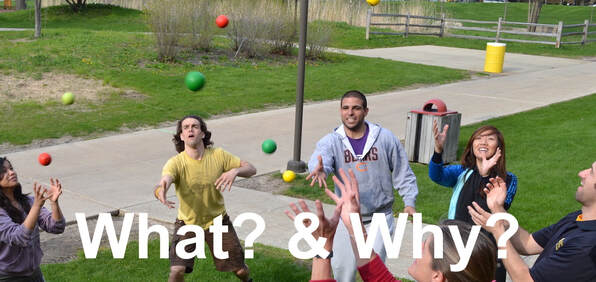
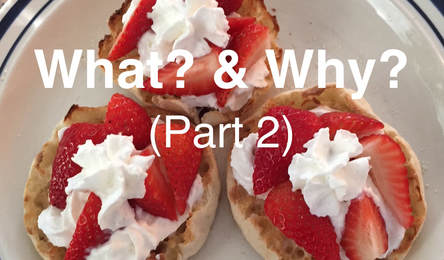
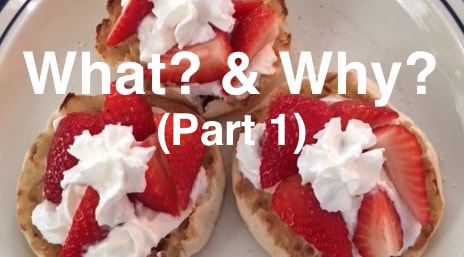
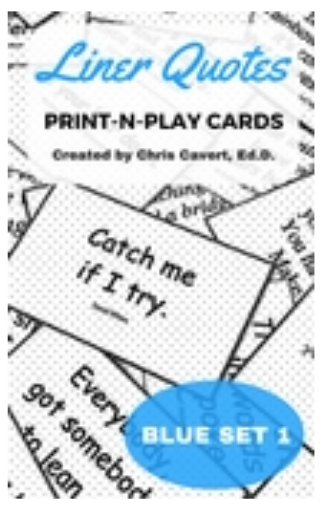
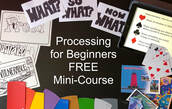

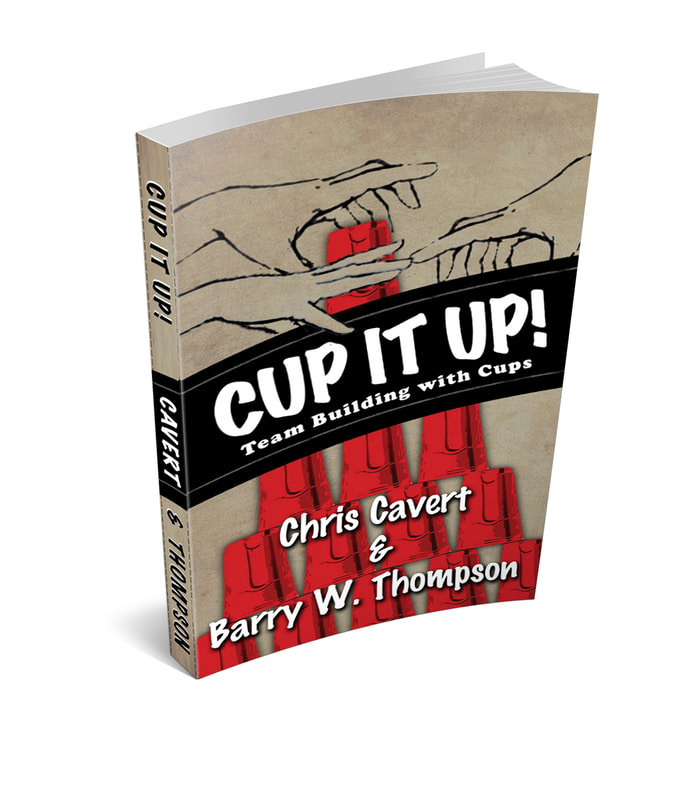
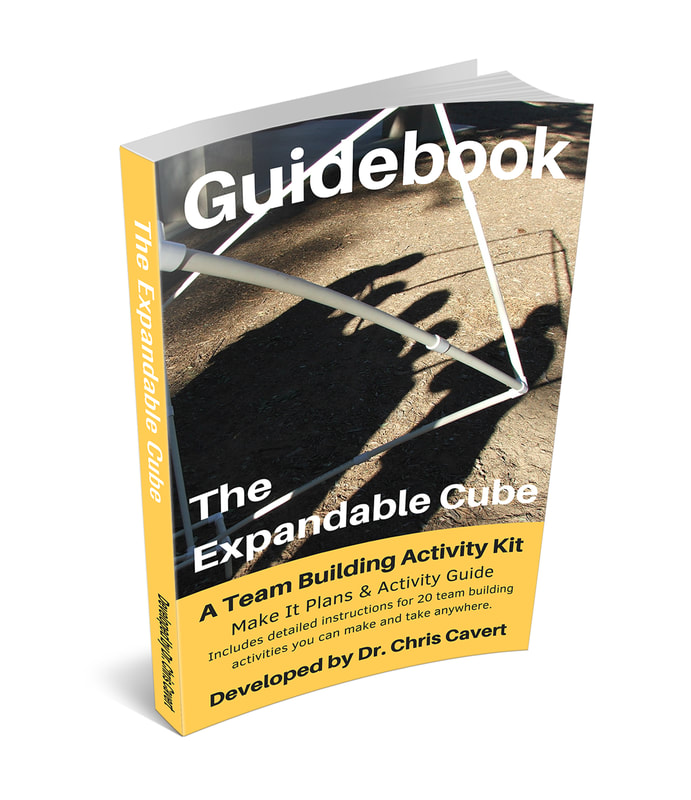
 RSS Feed
RSS Feed